Onager
| Onager[1] Temporal range: 4.5–0 Ma | |
|---|---|
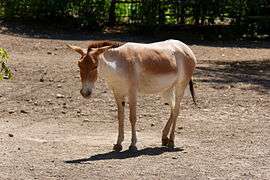 | |
| A Persian onager (Equus hemionus onager) at Rostov-on-Don Zoo, Russia. | |
| Scientific classification | |
| Kingdom: | Animalia |
| Phylum: | Chordata |
| Class: | Mammalia |
| Order: | Perissodactyla |
| Family: | Equidae |
| Genus: | Equus |
| Subgenus: | Asinus |
| Species: | E. hemionus |
| Binomial name | |
| Equus hemionus Pallas, 1775 | |
| Subspecies | |
|
E. h. hemionus (Pallas, 1775) | |
 | |
| Equus hemionus range | |
| Synonyms | |
|
Equus onager Boddaert, 1785 | |
The onager (Equus hemionus) (pronounced /ˈɒ-ni-jə(r)/), also known as hemione or Asiatic wild ass,[3] is a large equid of the family Equidae (horse family) native to Asia. A member of the subgenus Asinus, the onager was described and given its binomial name by German zoologist Peter Simon Pallas in 1775. Five subspecies have been recognized, one of which is extinct.
The Asiatic wild ass is larger than African wild ass at about 290 kg (640 lb) and 2.1 m (6.9 ft) (head-body length). They are reddish-brown or yellowish-brown in color and have broad dorsal stripe on the middle of the back. Unlike most horses and donkeys, onagers have never been domesticated. They are among the fastest mammals, as they can run as fast as 64 km/h (40 mph) to 70 km/h (43 mph). The onager is closely related to the African wild ass, as they both shared the same ancestor. The kiang, formerly considered a subspecies of Equus hemionus, diverged from the Asiatic wild ass and has been acknowledged as a distinct species.[4]
The onager formerly had a wider range from southwest and central to northern Asian countries, such as Israel, Saudi Arabia, Iraq, Syria, Afghanistan, Russia, and Siberia. During early 20th century, the species lost most of its ranges in the Middle East and Eastern Asia. Today, onagers live in deserts and other arid regions of Iran, Pakistan, India, and Mongolia, including in Central Asian hot and cold deserts of Kazakhstan, Uzbekistan, Turkmenistan, and China.[1]
Other than deserts, it lives in grasslands, plains, steppes, and savannahs. Like many other large grazing animals, the onager's range has contracted greatly under the pressures of poaching and habitat loss.[3] Previously listed as Endangered, onagers have been classified as Near Threatened by IUCN in 2015.[2] Of the five subspecies, one is extinct, two are endangered, and two are near threatened (their status in China is not well known).[3] Persian onagers are currently being reintroduced in the Middle East as replacement for the extinct Syrian wild ass in the Arabian Peninsula, Israel and Jordan.
Etymology
The specific name is Ancient Greek ἡμίονος (hēmíonos), from ἡμι- (hēmi-), half, and ὄνος (ónos), donkey; thus, half-donkey or mule. In Persian the archaic word gur preserves the second syllable of the common Indo-European term that includes ona/ono (donkey) and ger/gur (swift).
The species was commonly known as Asian wild ass, in which case the term "onager" was reserved for the E. h. onager subspecies,[3] more specifically known as the Persian onager. Until this day, the species share the same name, "onager".
Taxonomy and evolution
The onager is a member of the Subgenus Asinus, belonging to the genus Equus and is classified under the family Equidae. The species was described and given its binomial name Equus hemionus by German zoologist Peter Simon Pallas in 1775.
The Asiatic wild ass, among Old World equids, existed for more than 4 million years. The oldest divergence of Equus was the onager followed by the zebras and onwards.[5] A new species called the kiang (E. kiang), a Tibetan relative, was previously considered to be a subspecies of the onager as E. hemionus kiang, but recent molecular studies indicate it to be a distinct species, having diverged from the closest relative of the Mongolian wild ass's ancestor less than 500,000 years ago.[6]
| |
| ||||||||||||||||||||||||
| |
Subspecies
Widely five recognized subspecies of the onager include:[3]
| Subspecies | Image | Trinomial authority | Description | Range | Synonyms |
|---|---|---|---|---|---|
| Mongolian wild ass (khulan) E. h. hemionus Nominate subspecies |
.jpg) |
Pallas, 1775 | Northern China, eastern Kazakhstan, Mongolia, and Siberia. | bedfordi (Matschie 1911) findschi (Matschie 1911) luteus (Matschie 1911) | |
| Turkmenian kulan (kulan) E. h. kulan |
Groves and Mazák, 1967 | Is one of the largest subspecies of the onagers. It is 200–250 cm long, 100–140 cm tall at the shoulder, and it weighs 200–240 kg. Male onagers are larger than the females. | Northern Afghanistan, western China, Kazakhstan, Kyrgyzstan, southern Siberia, Tajikistan, Turkmenistan and Uzbekistan | finschi (Matschie, 1911) | |
| Persian onager (gur) E. h. onager |
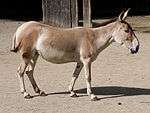 |
Boddaert, 1785 | Afghanistan, Iran and Pakistan. | ||
| Indian wild ass (khur) E. h. khur |
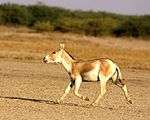 |
Lesson, 1827 | Southern Afghanistan, India, southeast Iran and Pakistan. | indicus (Sclater, 1862) | |
| †Syrian wild ass (hemippe) E. h. hemippus |
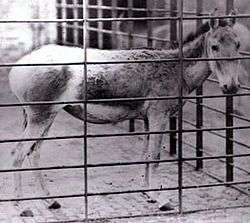 |
Geoffroy, 1855 | Smallest subspecies, also the smallest form of Equidae. | Western Iran, Iraq, Israel, Jordan, Saudi Arabia, Syria, and Turkey. | syriacus (Milne-Edwards, 1869) |
A sixth possible subspecies, the Gobi khulan (E. h. luteus,[2] also called the chigetai[7] or dziggetai) has been proposed, but may be synonymous with E. h. hemionus.
Debates over the taxonomic identity of the onager occurred until in 1980. As of today, four living subspecies and one extinct subspecies of the Asiatic wild ass have been recognized. The Persian onager was formerly known as Equus onager, as it was thought to be a distinct species.
Characteristics
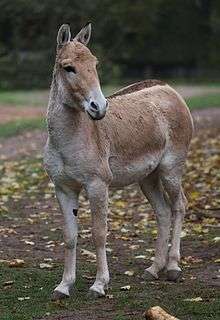
Onagers are the most horse-like of wild asses. Onagers are short-legged compared to horses, and their coloring varies depending on the season. They are generally reddish-brown in color during the summer, becoming yellowish-brown or grayish-brown in the winter. They have a black stripe bordered in white that extends down the middle of the back. The belly, the buttocks and the muzzle are white in most onagers, except for the Mongolian wild ass that has a broad black dorsal stripe bordered with white.
Onagers are larger than donkeys at about 200 kg (440 lb) to 290 kg (640 lb) in size and 2.1 m (6.9 ft) to 2.5 m (8.2 ft) in head-body length. Male onagers are usually larger than females.
Distribution and habitat

The onagers' favored habitats consist of desert plains, semi-deserts, oases, arid grasslands, savannahs, shrublands, steppes, mountainous steppes and mountain ranges. The Turkmenian kulan and Mongolian wild asses are known to live in hot and colder deserts. It is estimated by the IUCN that there are about 28,000 mature individuals in total in the wild.[2]
During the late Pleistocene era around 40,000 years ago, the Asiatic wild ass ranged widely across Europe, in southwestern to northeastern Asia. The onager have been regionally extinct in Israel, Saudi Arabia, Iraq, Jordan, Syria, and southern regions of Siberia.

The Mongolian wild ass lives in deserts, mountains and grasslands of Mongolia and Inner Mongolian region of northern China. A few live in northern Xinjiang region of northwestern China, most of which live mainly in Kalamaili Nature Reserve. It is the most common subspecies, but its populations have drastically decreased to a few thousand due to years of poaching and habitat loss in East Asia. The Gobi Desert is the onager's main stronghold. It is regionally extinct in eastern Kazakhstan, southern Siberia and the Manchurian region of China.
The Indian wild ass was once found throughout the arid parts and desert steppes of northwest India and Pakistan, but about 4,500 of them are found in a few very hot wildlife sanctuaries of Gujarat. The Persian onager is found in two subpopulations in southern and northern Iran. The larger population is found at Khar Turan National Park. However, it is extinct in the wild of Afghanistan. The Turkmenian kulan used to be widespread in central to north Asia. However, it is now found in Turkmenistan and has been reintroduced in southern Kazakhstan and Uzbekistan.
Biology and behavior
Asiatic wild ass are mostly active at dawn and dusk, even during the intense heat.
Social structure
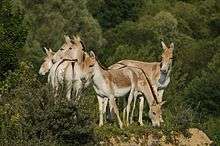
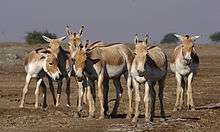
Like most equids, onagers are social animals. Stallions are either solitary or they live in groups of two or three. The males have been observed holding harems of females, but in other studies, the dominant stallions defend territories that attract females. Differences in behaviour and social structure likely are the result of changes in climate, vegetation cover, predation, and hunting.
The social behavior of the Asian wild ass can be very different, depending on different habitats, ranges and even threats by predators and humans. In Mongolia and Central Asia (Equus hemionus hemionus and Equus hemionus kulan), a stove onager stallion can adopt harem-type social groups with several mares and foals in large home areas in the southwest and territory-based social groups in the south and southeast. Also, annual large hikes occur 45 km2 (17 sq mi) to 40 km2 (15 sq mi), where hiking in summer are more limited than in the winter. Partially, onagers also form large group associations of up from 450 to 1,200 individuals, but this usually only takes place on locations with food or water sources. Since dissolving these major units within one day again, there seems to be no overarching hierarchy next to the ranking of the individual herds. There are also "bachelor groups" that young male onagers frequently make during the winter. Such a lifestyle is also seen in the wild horse, the plains zebras (Equus quagga) and mountain zebras (Equus zebra). However, occasional formation of temporary territories can be defended in an aggressive way.
Southern populations of onagers in the Middle East and South Asia tend to have a purely territorial life, where areas partly overlap. Dominant stallions home ranges of 9 km2 (3.5 sq mi), but can also be significantly larger. These territories include food and rest stops and permanent or periodic water sources. The waters are but usually at the edge of a coalfield and not in the center. Frequently committed paths with feces and marked urine, where often the same marker points are used. Mares with foals sometimes find themselves also to small groups, the areas of up to 20 km2 (7.7 sq mi) which overlap with those of the other groups and dominant stallions. Such features are seen in Grévy's zebras (Equus grevyi) and the African wild asses.
Reproduction
The Asian wild ass is sexually mature at two years old, the first mating usually takes place at three to four years old.
Breeding is seasonal, and the gestation period of onagers is 11 months and the birth lasts a little more than 10 minutes. Mating and births occur from April to September, and there is an accumulation from June to July. The mating season in India is in the rainy season. The foal can stand and starts to suck milk within 15 to 20 minutes after the latest one and a half hours. Females with young tend to form groups of up to five females. During the rearing foals and dam remain closely, other animals, also own older juveniles are displaced by the dam. Occasionally, stallions in territorial wild populations expel the young to mate with the mare again. Wild Asian wild asses reach an age of 14 years, however in captivity, they can live up to 26 years.
Diet

Like all equids, onagers are herbivorous mammals. They eat grasses, herbs, leaves, fruits, and saline vegetation when available, but browse on shrubs and trees in drier habitats. They have also been seen feeding on seed pods such as Prosopis and breaking up woody vegetation with their hooves to get at more succulent herbs growing at the base of woody plants.
During the winter, onagers also eat snow as a substitute for water. When natural water sources are unavailable, the Asiatic wild ass digs holes in dry riverbeds to access subsurface water. The water holes dug by the wild asses are often subsequently visited by domestic livestock, as well as other wild animals. Water is also found in the plants on which the onagers feed.
During spring and summer in Mongolia, the succulent plants of the Zygophyllaceae family form an important component of the diet of the Mongolian wild ass.
Predation
.jpg)
The onager is preyed upon by apex predators such as Asiatic leopards and striped hyenas. A few cases of onager deaths due to predation by leopards was recorded in Iran, as a Persian leopard attacked and eaten a Persian onager. Though it is said that leopards do not usually feed on equids such as in Africa, it may be due that Asian leopards are larger and stronger enough to prey on Asiatic wild asses.[8][9]
In the Middle East to the Indian Subcontinent, Asiatic lions and tigers were the biggest predators to onagers, just as African lions are to zebras. They were also formerly by Asiatic wild dogs, Asiatic cheetahs and possibly bears in their former neighboring ranges, though they may have mostly preyed on onager foals. In South Asia, mugger crocodiles can be great threats to onagers during migratory river crossings.
Currently, the biggest predator for onagers are gray wolves. Investigations revealed that a 23% of prey proportion of gray wolves were attributed to the Asian wild ass. However, like most equids, they are known to have anti-predator protection. Groups of stallions cooperate and try to chase off predators. If threatened, onagers defend themselves and violently kick at the incoming predator.
Threats
The greatest threat facing the onager is poaching for meat and hides, and in some areas for use in traditional medicine. It is the one of highest threats for the Mongolian wild ass. The extreme isolation of many subpopulations also threatens the species, as genetic problems can result from inbreeding. Overgrazing by livestock reduces food availability, and herders also reduce the availability of water at springs. The cutting down of nutritious shrubs and bushes exacerbates the problem. Furthermore, a series of drought years could have devastating effects on this beleaguered species.
Habitat loss and fragmentation are also major threats to the onager, a particular concern in Mongolia as a result of the increasingly dense network of roads, railway lines, and fences required to support mining activities.
The Asiatic wild ass is vulnerable to diseases, as well. A disease known as the "South African horse sickness" caused a major decline to the Indian wild ass population in the 1960s. Fortunately, the subspecies is no longer under threat to such disease and is continuously increasing their numbers.
Conservation
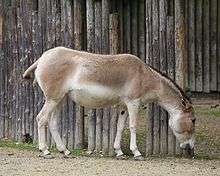
Various breeding programs have been started for the onager subspecies in captivity and in the wild, which increases their numbers to save the endangered species. The species is legally protected in many of the countries in which it occurs. The priority for future conservation measures is to ensure the protection of this species in particularly vulnerable parts of its range, to encourage the involvement of local people in the conservation of the onager, and to conduct further research into the behavior, ecology, and taxonomy of the species.
Two onager subspecies, the Persian onager and the Turkmenian kulan are being reintroduced to their former ranges, including in other regions the Syrian wild ass used to occur in the Middle East. The two subspecies have been reintroduced to the wild of Israel since 1982, and had been breeding hybrids there,[10] whilst the Persian onager alone has been reintroduced to Jordan and the deserts of Saudi Arabia.
Interaction with human beings
Onagers are notoriously untamable. Equids were used in ancient Sumer to pull wagons circa 2600 BC, and then chariots on the Standard of Ur, circa 2550 BC. Clutton-Brock (1992) suggests that these were donkeys rather than onagers on the basis of a "shoulder stripe".[11] However, close examination of the animals (equids, sheep and cattle) on both sides of the piece indicate that what appears to be a stripe may well be a harness, a trapping, or a joint in the inlay.[12][13]
See also
References
- 1 2 Grubb, P. (2005). "Order Perissodactyla". In Wilson, D.E.; Reeder, D.M. Mammal Species of the World: A Taxonomic and Geographic Reference (3rd ed.). Johns Hopkins University Press. p. 632. ISBN 978-0-8018-8221-0. OCLC 62265494.
- 1 2 3 4 Kaczensky, P.; Lkhagvasuren, B.; Pereladova, O.; Hemami, M. & Bouskila, A. (2015). "Equus hemionus". IUCN Red List of Threatened Species. Version 2015.2. International Union for Conservation of Nature. Retrieved 10 Jan 2016.
- 1 2 3 4 5 "Asiatic Wild Ass Equus hemionus". IUCN.org. Gland, Switzerland: IUCN/SSC Equid Specialist Group.
- ↑ Ryder, O.A. & Chemnick, L.G. (1990). "Chromosomal and molecular evolution in Asiatic wild asses". Genetica. 83 (1): 67–72. doi:10.1007/BF00774690.
- ↑ Weinstock, J.; et al. (2005). "Evolution, systematics, and phylogeography of Pleistocene horses in the New World: a molecular perspective". PLoS Biology. 3 (8): e241. doi:10.1371/journal.pbio.0030241. PMC 1159165
 . PMID 15974804. Retrieved 2008-12-19.
. PMID 15974804. Retrieved 2008-12-19. - ↑ Ryder OA, Chemnick LG (1990). "Chromosomal and molecular evolution in Asiatic wild asses.". PubLMed.gov. Retrieved 14 October 2015.
- ↑ Ian Lauder Mason (2002). Porter, Valerie, ed. Mason's World Dictionary of Livestock Breeds, Types, and Varieties (5th ed.). Wallingford: CABI. ISBN 0-85199-430-X.
- ↑ Sanei, A., Zakaria, M., Hermidas, S. (2011). "Prey composition in the Persian leopard distribution range in Iran". ResearchGate. Retrieved 3 July 2016.
- ↑ Persian Leopard Newsletter No.4 (PDF). Wildlife.ir. 2010. Retrieved 3 July 2016.
- ↑ Saltz, D. (1995). "Population dynamics of a reintroduced Asiatic wild ass (Equus Hemionus) herd". Ecological Applications. 5 (2): 327–335. doi:10.2307/1942025.
- ↑ Clutton-Brock, Juliet (1992). Horse Power: A History of the Horse and the Donkey in Human Societies. Boston, Massachusetts, US: Harvard University Press. ISBN 978-0-674-40646-9.
- ↑ Heimpel, Wolfgang (1968). Tierbilder in der Sumerische Literatur. Italy: Studia Pohl 2.
- ↑ Maekawa, K. (1979). "The Ass and the Onager in Sumer in the Late Third Millennium B.C.". Acta Sumerologica'. Hiroshima. I: 35–62.
- Duncan, P. (ed.). 1992. Zebras, Asses, and Horses: an Action Plan for the Conservation of Wild Equids. IUCN/SSC Equid Specialist Group. IUCN, Gland, Switzerland.
External links
| Look up onager in Wiktionary, the free dictionary. |
| Wikimedia Commons has media related to Equus hemionus. |
| Wikispecies has information related to: Equus hemionus |

.jpg)